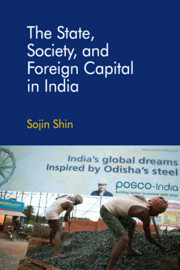Book contents
- Frontmatter
- Dedication
- Contents
- List of Tables, Figures, Illustrations, and Maps
- Acknowledgements
- 1 Introduction
- 2 FDI Inflows in India: Ideas, Interests, and Institutional Change
- 3 FDI Inflows in Tamil Nadu: Inclusionary Ideas, Weakened Interests, and Incremental Institutional Change
- 4 Making FDI Work in Tamil Nadu
- 5 FDI Inflows in Odisha: Weakened Ideas, Strong Interests, and Unstable Institutional Change
- 6 Making FDI Work in Odisha?
- 7 Conclusion
- Bibliography
- Index
1 - Introduction
Published online by Cambridge University Press: 08 July 2018
- Frontmatter
- Dedication
- Contents
- List of Tables, Figures, Illustrations, and Maps
- Acknowledgements
- 1 Introduction
- 2 FDI Inflows in India: Ideas, Interests, and Institutional Change
- 3 FDI Inflows in Tamil Nadu: Inclusionary Ideas, Weakened Interests, and Incremental Institutional Change
- 4 Making FDI Work in Tamil Nadu
- 5 FDI Inflows in Odisha: Weakened Ideas, Strong Interests, and Unstable Institutional Change
- 6 Making FDI Work in Odisha?
- 7 Conclusion
- Bibliography
- Index
Summary
Empirical puzzles
On the evening of 18 March 2017, The Economic Times informed that POSCO, the world's fifth-largest steel producer from South Korea, would drop its US$12 billion steel project in the eastern Indian state of Odisha. After signing a Memorandum of Understanding (MOU) with the Government of Odisha in June 2005, it took as many as twelve years for POSCO to decide to cease its investment project. Odisha is one of the provincial states in India possessing abundant natural resources, such as iron-ore, bauxite, and many other minerals. Despite having heavy stock of natural resources, Odisha is, ironically, one of the economically most backward and the least industrialised states. It was believed that the district of Jagatsinghpur, where POSCO's steel project was to take place, would transform like Rourkela, which became a wealthy and modernised city in Odisha through the establishment of the Rourkela Steel Plant built in the early years of post-colonial period.
POSCO's withdrawal from its steel project in Odisha was not shocking. POSCO had invested heavily in the project that eventually became one of the most controversial and highly politicised foreign investments in India. A variety of groups and organisations protested against POSCO in the past twelve years. While different groups of people were seeking to enhance their interests through the protests, which grew as big as a movement, villagers in Kujang got increasingly polarised. Political leaders, bureaucrats, foreign investors, and local citizens were entangled in POSCO's steel plan.
In fact, POSCO was not the only investor that had difficulties in carrying out a large-scale investment plan in the state. TATA Steel, the world's 10th largest steel producer based in India, also struggled for more than seven years in building its steel plant in Kalinga Nagar after signing an MOU with the Government of Odisha in 2004. Despite the struggle, TATA has managed to set it up.
What makes it difficult to materialise the large-scale investment projects in Odisha? Does the resource extractive nature of steel industry act as a barrier? If so, why did others struggle while the Rourkela steel project was viable? Does the timing of investments matter? If yes, how do we explain the subtle or substantial distinction between POSCO and TATA, a dropout and a survivor in the long and lagging investment process?
- Type
- Chapter
- Information
- The State, Society, and Foreign Capital in India , pp. 1 - 22Publisher: Cambridge University PressPrint publication year: 2018

